Analysis of Field Grid-Based Energy Storage Systems: Research
VerifiedAdded on 2021/04/22
|14
|3520
|202
Report
AI Summary
This research paper provides a detailed overview of field grid-based energy storage systems, focusing on their principles of operation, advantages, and various implemented technologies. It discusses pumped hydro energy storage, explaining its construction, features, and working principles, along with its applications in locations like the Tianhuangping Pumped Storage Power Station. The paper also examines compressed air energy storage systems and their potential to integrate with renewable energy sources. Furthermore, it presents a design for a pumped hydro system intended to deliver 0.5 MVA into a 50Hz grid, outlining the calculations for power, discharge, and turbine speed. The report emphasizes the importance of energy storage in meeting fluctuating energy demands and maximizing the use of renewable energy, highlighting its role in improving grid efficiency and enabling participation in demand response markets. Desklib offers a platform to explore similar solved assignments and research papers.
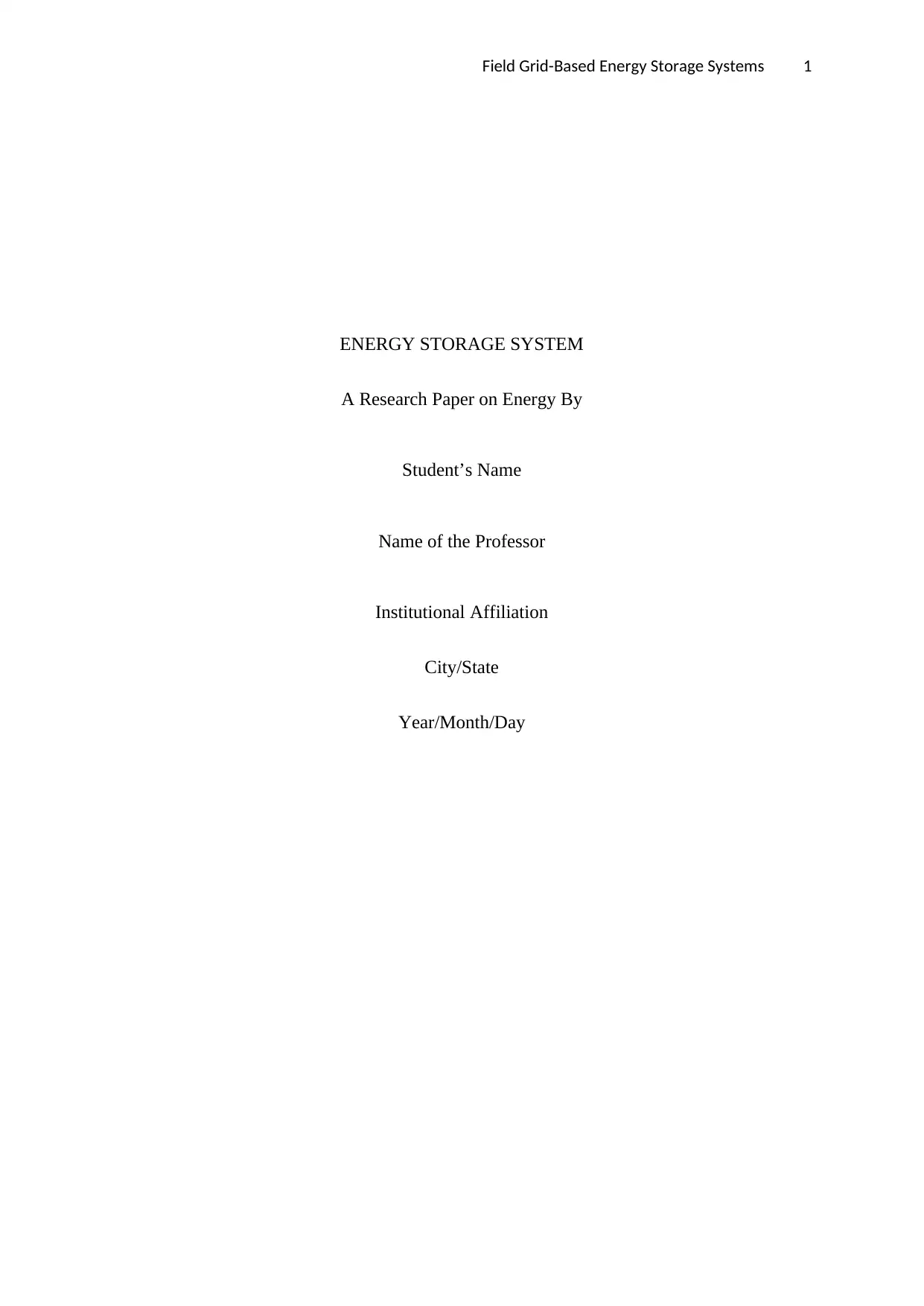
Field Grid-Based Energy Storage Systems 1
ENERGY STORAGE SYSTEM
A Research Paper on Energy By
Student’s Name
Name of the Professor
Institutional Affiliation
City/State
Year/Month/Day
ENERGY STORAGE SYSTEM
A Research Paper on Energy By
Student’s Name
Name of the Professor
Institutional Affiliation
City/State
Year/Month/Day
Paraphrase This Document
Need a fresh take? Get an instant paraphrase of this document with our AI Paraphraser
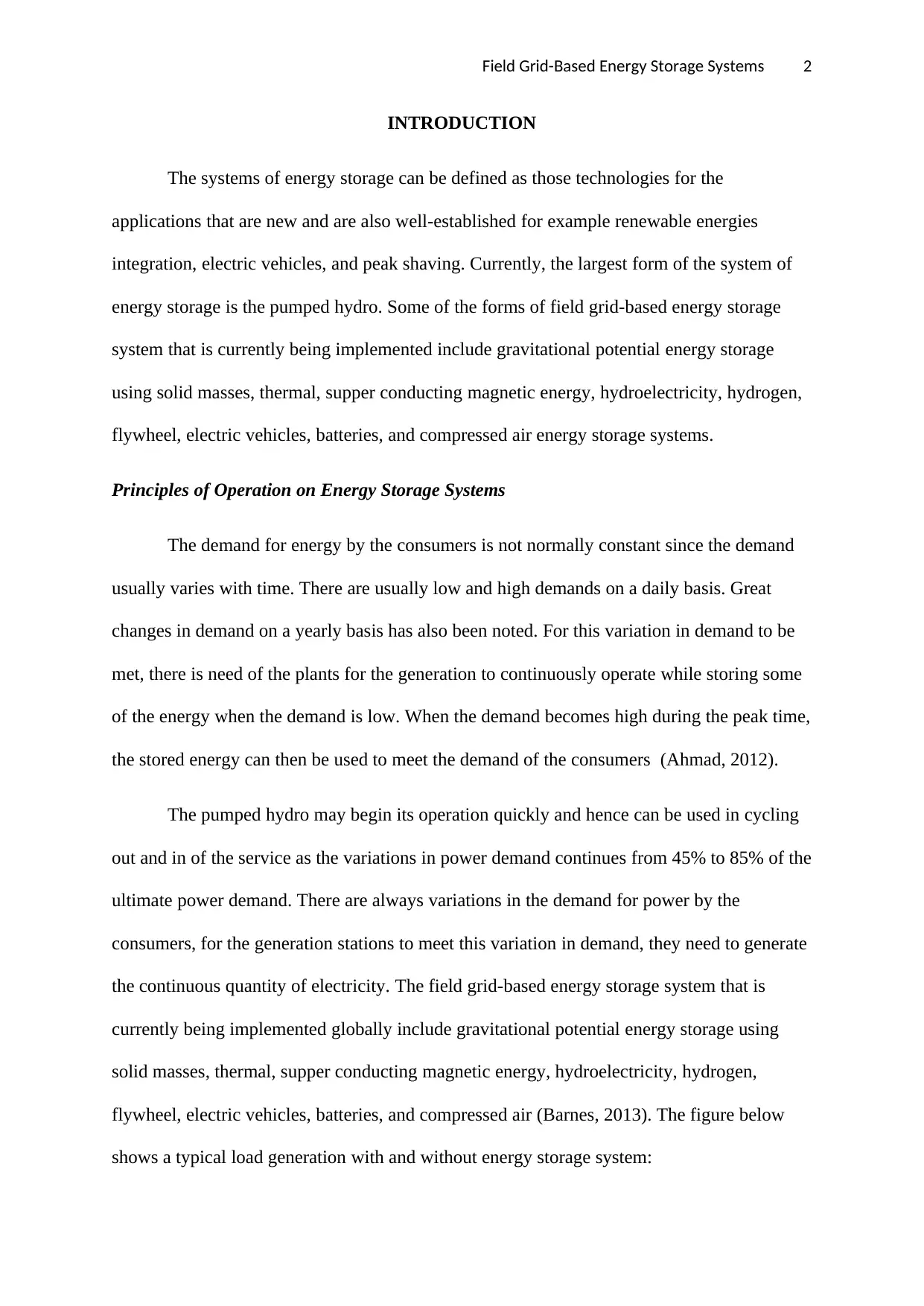
Field Grid-Based Energy Storage Systems 2
INTRODUCTION
The systems of energy storage can be defined as those technologies for the
applications that are new and are also well-established for example renewable energies
integration, electric vehicles, and peak shaving. Currently, the largest form of the system of
energy storage is the pumped hydro. Some of the forms of field grid-based energy storage
system that is currently being implemented include gravitational potential energy storage
using solid masses, thermal, supper conducting magnetic energy, hydroelectricity, hydrogen,
flywheel, electric vehicles, batteries, and compressed air energy storage systems.
Principles of Operation on Energy Storage Systems
The demand for energy by the consumers is not normally constant since the demand
usually varies with time. There are usually low and high demands on a daily basis. Great
changes in demand on a yearly basis has also been noted. For this variation in demand to be
met, there is need of the plants for the generation to continuously operate while storing some
of the energy when the demand is low. When the demand becomes high during the peak time,
the stored energy can then be used to meet the demand of the consumers (Ahmad, 2012).
The pumped hydro may begin its operation quickly and hence can be used in cycling
out and in of the service as the variations in power demand continues from 45% to 85% of the
ultimate power demand. There are always variations in the demand for power by the
consumers, for the generation stations to meet this variation in demand, they need to generate
the continuous quantity of electricity. The field grid-based energy storage system that is
currently being implemented globally include gravitational potential energy storage using
solid masses, thermal, supper conducting magnetic energy, hydroelectricity, hydrogen,
flywheel, electric vehicles, batteries, and compressed air (Barnes, 2013). The figure below
shows a typical load generation with and without energy storage system:
INTRODUCTION
The systems of energy storage can be defined as those technologies for the
applications that are new and are also well-established for example renewable energies
integration, electric vehicles, and peak shaving. Currently, the largest form of the system of
energy storage is the pumped hydro. Some of the forms of field grid-based energy storage
system that is currently being implemented include gravitational potential energy storage
using solid masses, thermal, supper conducting magnetic energy, hydroelectricity, hydrogen,
flywheel, electric vehicles, batteries, and compressed air energy storage systems.
Principles of Operation on Energy Storage Systems
The demand for energy by the consumers is not normally constant since the demand
usually varies with time. There are usually low and high demands on a daily basis. Great
changes in demand on a yearly basis has also been noted. For this variation in demand to be
met, there is need of the plants for the generation to continuously operate while storing some
of the energy when the demand is low. When the demand becomes high during the peak time,
the stored energy can then be used to meet the demand of the consumers (Ahmad, 2012).
The pumped hydro may begin its operation quickly and hence can be used in cycling
out and in of the service as the variations in power demand continues from 45% to 85% of the
ultimate power demand. There are always variations in the demand for power by the
consumers, for the generation stations to meet this variation in demand, they need to generate
the continuous quantity of electricity. The field grid-based energy storage system that is
currently being implemented globally include gravitational potential energy storage using
solid masses, thermal, supper conducting magnetic energy, hydroelectricity, hydrogen,
flywheel, electric vehicles, batteries, and compressed air (Barnes, 2013). The figure below
shows a typical load generation with and without energy storage system:
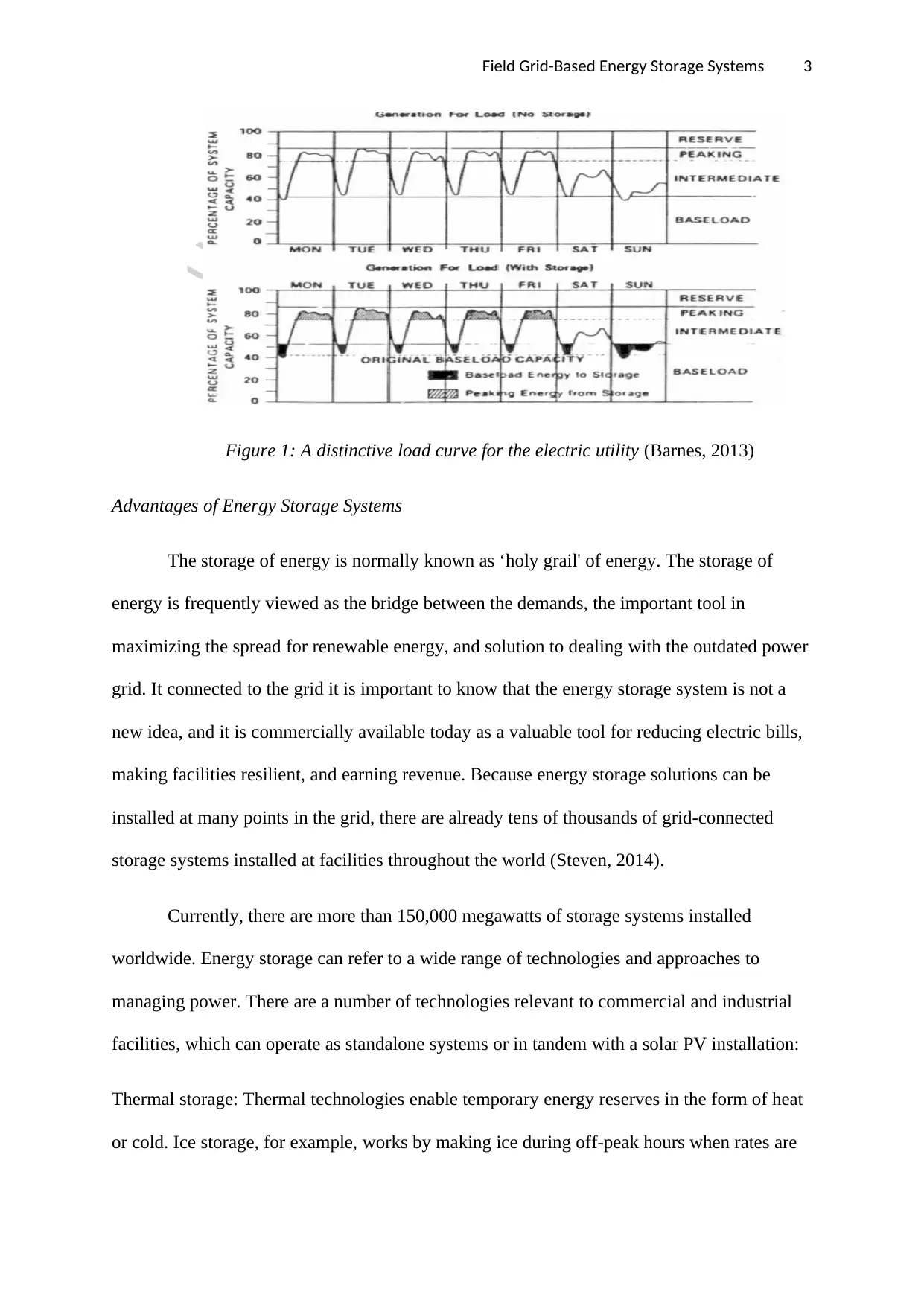
Field Grid-Based Energy Storage Systems 3
Figure 1: A distinctive load curve for the electric utility (Barnes, 2013)
Advantages of Energy Storage Systems
The storage of energy is normally known as ‘holy grail' of energy. The storage of
energy is frequently viewed as the bridge between the demands, the important tool in
maximizing the spread for renewable energy, and solution to dealing with the outdated power
grid. It connected to the grid it is important to know that the energy storage system is not a
new idea, and it is commercially available today as a valuable tool for reducing electric bills,
making facilities resilient, and earning revenue. Because energy storage solutions can be
installed at many points in the grid, there are already tens of thousands of grid-connected
storage systems installed at facilities throughout the world (Steven, 2014).
Currently, there are more than 150,000 megawatts of storage systems installed
worldwide. Energy storage can refer to a wide range of technologies and approaches to
managing power. There are a number of technologies relevant to commercial and industrial
facilities, which can operate as standalone systems or in tandem with a solar PV installation:
Thermal storage: Thermal technologies enable temporary energy reserves in the form of heat
or cold. Ice storage, for example, works by making ice during off-peak hours when rates are
Figure 1: A distinctive load curve for the electric utility (Barnes, 2013)
Advantages of Energy Storage Systems
The storage of energy is normally known as ‘holy grail' of energy. The storage of
energy is frequently viewed as the bridge between the demands, the important tool in
maximizing the spread for renewable energy, and solution to dealing with the outdated power
grid. It connected to the grid it is important to know that the energy storage system is not a
new idea, and it is commercially available today as a valuable tool for reducing electric bills,
making facilities resilient, and earning revenue. Because energy storage solutions can be
installed at many points in the grid, there are already tens of thousands of grid-connected
storage systems installed at facilities throughout the world (Steven, 2014).
Currently, there are more than 150,000 megawatts of storage systems installed
worldwide. Energy storage can refer to a wide range of technologies and approaches to
managing power. There are a number of technologies relevant to commercial and industrial
facilities, which can operate as standalone systems or in tandem with a solar PV installation:
Thermal storage: Thermal technologies enable temporary energy reserves in the form of heat
or cold. Ice storage, for example, works by making ice during off-peak hours when rates are
⊘ This is a preview!⊘
Do you want full access?
Subscribe today to unlock all pages.

Trusted by 1+ million students worldwide
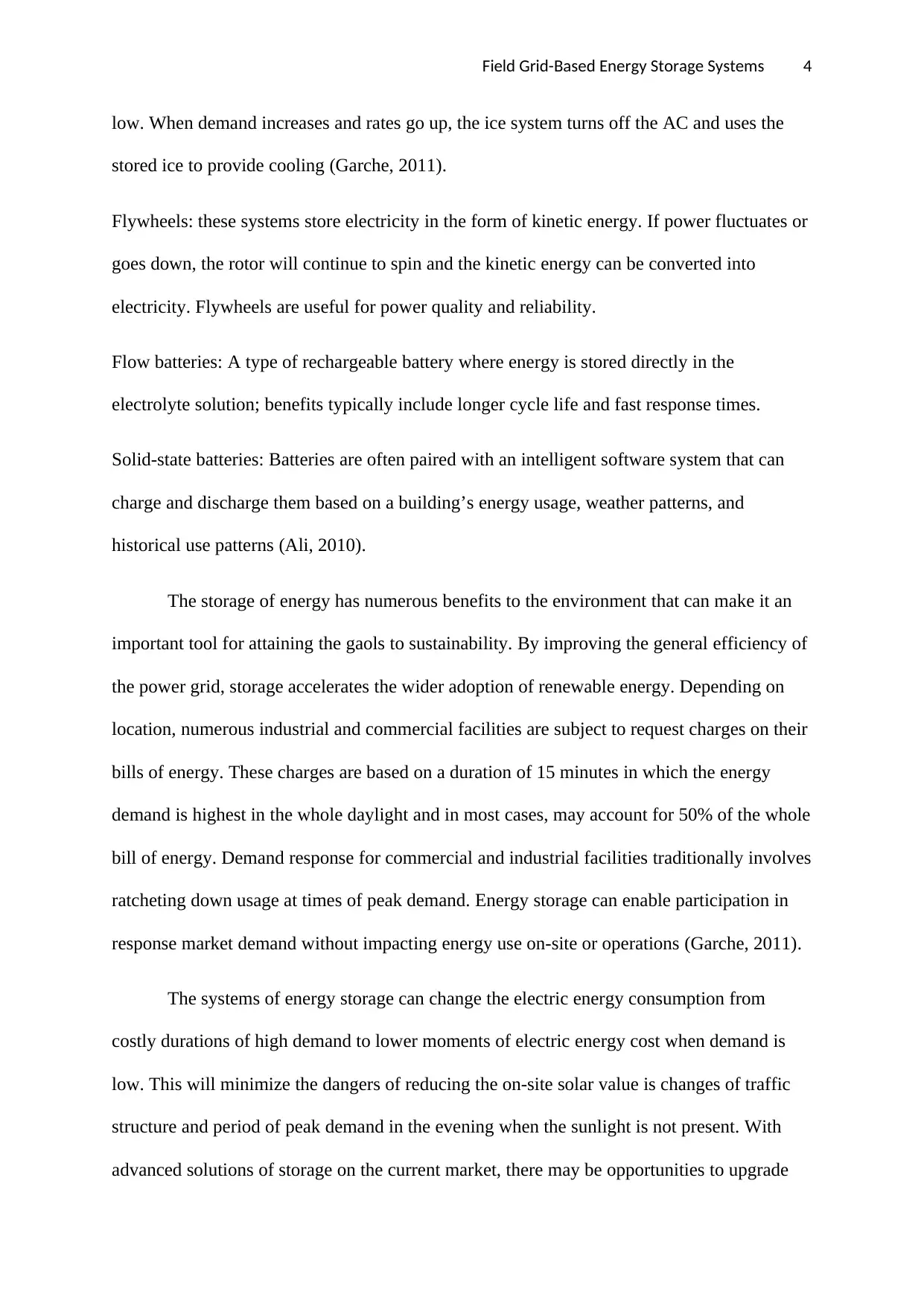
Field Grid-Based Energy Storage Systems 4
low. When demand increases and rates go up, the ice system turns off the AC and uses the
stored ice to provide cooling (Garche, 2011).
Flywheels: these systems store electricity in the form of kinetic energy. If power fluctuates or
goes down, the rotor will continue to spin and the kinetic energy can be converted into
electricity. Flywheels are useful for power quality and reliability.
Flow batteries: A type of rechargeable battery where energy is stored directly in the
electrolyte solution; benefits typically include longer cycle life and fast response times.
Solid-state batteries: Batteries are often paired with an intelligent software system that can
charge and discharge them based on a building’s energy usage, weather patterns, and
historical use patterns (Ali, 2010).
The storage of energy has numerous benefits to the environment that can make it an
important tool for attaining the gaols to sustainability. By improving the general efficiency of
the power grid, storage accelerates the wider adoption of renewable energy. Depending on
location, numerous industrial and commercial facilities are subject to request charges on their
bills of energy. These charges are based on a duration of 15 minutes in which the energy
demand is highest in the whole daylight and in most cases, may account for 50% of the whole
bill of energy. Demand response for commercial and industrial facilities traditionally involves
ratcheting down usage at times of peak demand. Energy storage can enable participation in
response market demand without impacting energy use on-site or operations (Garche, 2011).
The systems of energy storage can change the electric energy consumption from
costly durations of high demand to lower moments of electric energy cost when demand is
low. This will minimize the dangers of reducing the on-site solar value is changes of traffic
structure and period of peak demand in the evening when the sunlight is not present. With
advanced solutions of storage on the current market, there may be opportunities to upgrade
low. When demand increases and rates go up, the ice system turns off the AC and uses the
stored ice to provide cooling (Garche, 2011).
Flywheels: these systems store electricity in the form of kinetic energy. If power fluctuates or
goes down, the rotor will continue to spin and the kinetic energy can be converted into
electricity. Flywheels are useful for power quality and reliability.
Flow batteries: A type of rechargeable battery where energy is stored directly in the
electrolyte solution; benefits typically include longer cycle life and fast response times.
Solid-state batteries: Batteries are often paired with an intelligent software system that can
charge and discharge them based on a building’s energy usage, weather patterns, and
historical use patterns (Ali, 2010).
The storage of energy has numerous benefits to the environment that can make it an
important tool for attaining the gaols to sustainability. By improving the general efficiency of
the power grid, storage accelerates the wider adoption of renewable energy. Depending on
location, numerous industrial and commercial facilities are subject to request charges on their
bills of energy. These charges are based on a duration of 15 minutes in which the energy
demand is highest in the whole daylight and in most cases, may account for 50% of the whole
bill of energy. Demand response for commercial and industrial facilities traditionally involves
ratcheting down usage at times of peak demand. Energy storage can enable participation in
response market demand without impacting energy use on-site or operations (Garche, 2011).
The systems of energy storage can change the electric energy consumption from
costly durations of high demand to lower moments of electric energy cost when demand is
low. This will minimize the dangers of reducing the on-site solar value is changes of traffic
structure and period of peak demand in the evening when the sunlight is not present. With
advanced solutions of storage on the current market, there may be opportunities to upgrade
Paraphrase This Document
Need a fresh take? Get an instant paraphrase of this document with our AI Paraphraser
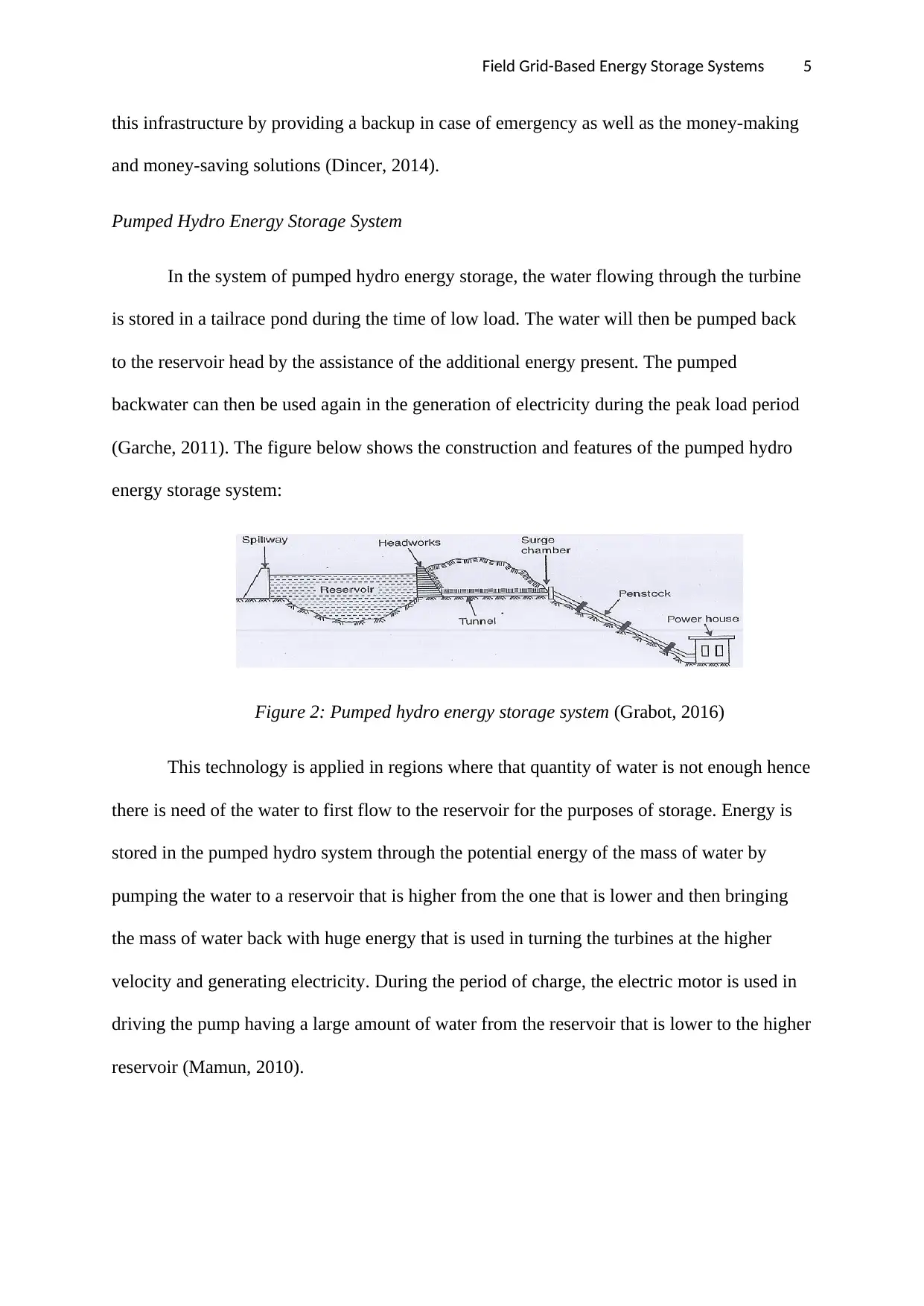
Field Grid-Based Energy Storage Systems 5
this infrastructure by providing a backup in case of emergency as well as the money-making
and money-saving solutions (Dincer, 2014).
Pumped Hydro Energy Storage System
In the system of pumped hydro energy storage, the water flowing through the turbine
is stored in a tailrace pond during the time of low load. The water will then be pumped back
to the reservoir head by the assistance of the additional energy present. The pumped
backwater can then be used again in the generation of electricity during the peak load period
(Garche, 2011). The figure below shows the construction and features of the pumped hydro
energy storage system:
Figure 2: Pumped hydro energy storage system (Grabot, 2016)
This technology is applied in regions where that quantity of water is not enough hence
there is need of the water to first flow to the reservoir for the purposes of storage. Energy is
stored in the pumped hydro system through the potential energy of the mass of water by
pumping the water to a reservoir that is higher from the one that is lower and then bringing
the mass of water back with huge energy that is used in turning the turbines at the higher
velocity and generating electricity. During the period of charge, the electric motor is used in
driving the pump having a large amount of water from the reservoir that is lower to the higher
reservoir (Mamun, 2010).
this infrastructure by providing a backup in case of emergency as well as the money-making
and money-saving solutions (Dincer, 2014).
Pumped Hydro Energy Storage System
In the system of pumped hydro energy storage, the water flowing through the turbine
is stored in a tailrace pond during the time of low load. The water will then be pumped back
to the reservoir head by the assistance of the additional energy present. The pumped
backwater can then be used again in the generation of electricity during the peak load period
(Garche, 2011). The figure below shows the construction and features of the pumped hydro
energy storage system:
Figure 2: Pumped hydro energy storage system (Grabot, 2016)
This technology is applied in regions where that quantity of water is not enough hence
there is need of the water to first flow to the reservoir for the purposes of storage. Energy is
stored in the pumped hydro system through the potential energy of the mass of water by
pumping the water to a reservoir that is higher from the one that is lower and then bringing
the mass of water back with huge energy that is used in turning the turbines at the higher
velocity and generating electricity. During the period of charge, the electric motor is used in
driving the pump having a large amount of water from the reservoir that is lower to the higher
reservoir (Mamun, 2010).
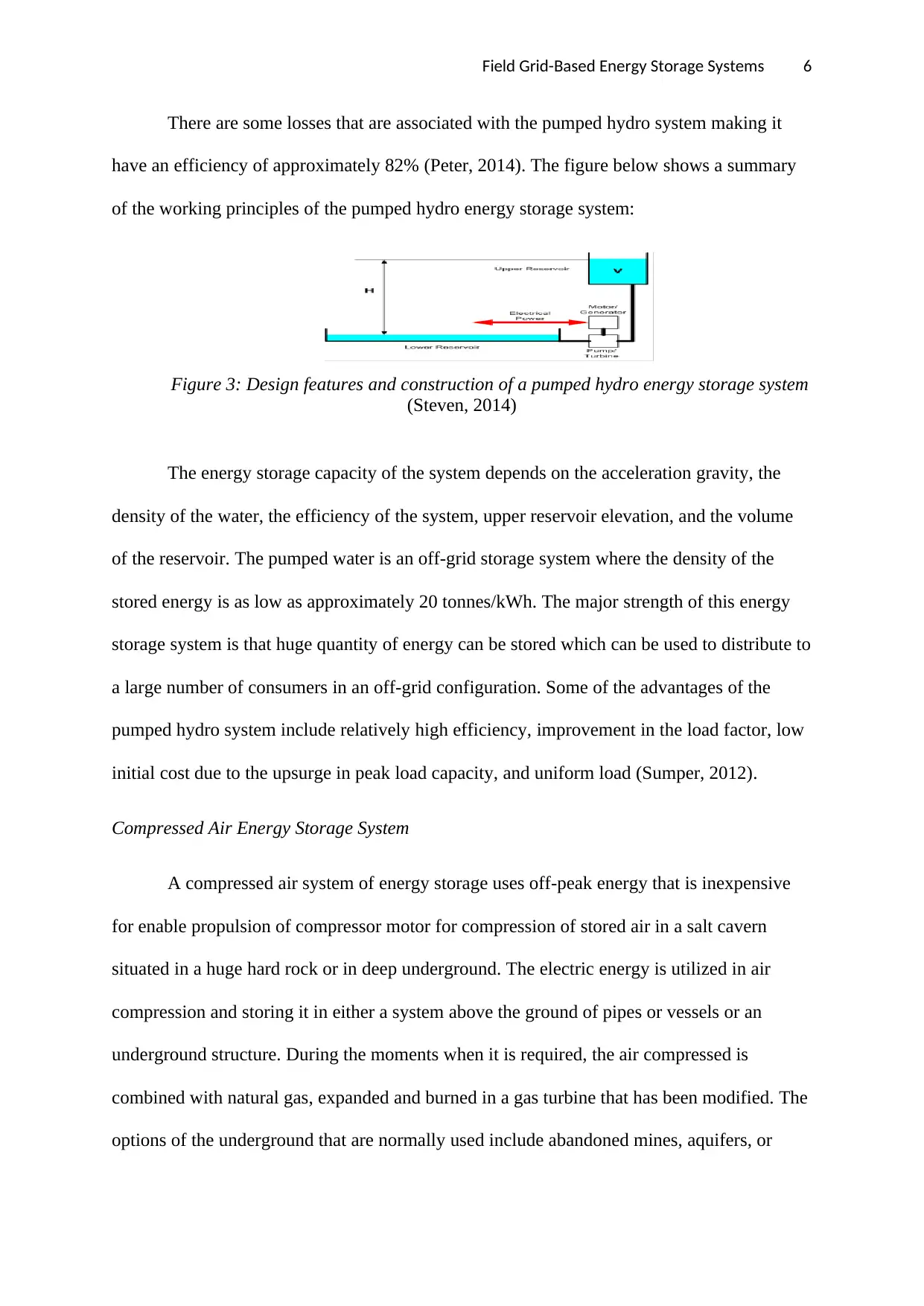
Field Grid-Based Energy Storage Systems 6
There are some losses that are associated with the pumped hydro system making it
have an efficiency of approximately 82% (Peter, 2014). The figure below shows a summary
of the working principles of the pumped hydro energy storage system:
Figure 3: Design features and construction of a pumped hydro energy storage system
(Steven, 2014)
The energy storage capacity of the system depends on the acceleration gravity, the
density of the water, the efficiency of the system, upper reservoir elevation, and the volume
of the reservoir. The pumped water is an off-grid storage system where the density of the
stored energy is as low as approximately 20 tonnes/kWh. The major strength of this energy
storage system is that huge quantity of energy can be stored which can be used to distribute to
a large number of consumers in an off-grid configuration. Some of the advantages of the
pumped hydro system include relatively high efficiency, improvement in the load factor, low
initial cost due to the upsurge in peak load capacity, and uniform load (Sumper, 2012).
Compressed Air Energy Storage System
A compressed air system of energy storage uses off-peak energy that is inexpensive
for enable propulsion of compressor motor for compression of stored air in a salt cavern
situated in a huge hard rock or in deep underground. The electric energy is utilized in air
compression and storing it in either a system above the ground of pipes or vessels or an
underground structure. During the moments when it is required, the air compressed is
combined with natural gas, expanded and burned in a gas turbine that has been modified. The
options of the underground that are normally used include abandoned mines, aquifers, or
There are some losses that are associated with the pumped hydro system making it
have an efficiency of approximately 82% (Peter, 2014). The figure below shows a summary
of the working principles of the pumped hydro energy storage system:
Figure 3: Design features and construction of a pumped hydro energy storage system
(Steven, 2014)
The energy storage capacity of the system depends on the acceleration gravity, the
density of the water, the efficiency of the system, upper reservoir elevation, and the volume
of the reservoir. The pumped water is an off-grid storage system where the density of the
stored energy is as low as approximately 20 tonnes/kWh. The major strength of this energy
storage system is that huge quantity of energy can be stored which can be used to distribute to
a large number of consumers in an off-grid configuration. Some of the advantages of the
pumped hydro system include relatively high efficiency, improvement in the load factor, low
initial cost due to the upsurge in peak load capacity, and uniform load (Sumper, 2012).
Compressed Air Energy Storage System
A compressed air system of energy storage uses off-peak energy that is inexpensive
for enable propulsion of compressor motor for compression of stored air in a salt cavern
situated in a huge hard rock or in deep underground. The electric energy is utilized in air
compression and storing it in either a system above the ground of pipes or vessels or an
underground structure. During the moments when it is required, the air compressed is
combined with natural gas, expanded and burned in a gas turbine that has been modified. The
options of the underground that are normally used include abandoned mines, aquifers, or
⊘ This is a preview!⊘
Do you want full access?
Subscribe today to unlock all pages.

Trusted by 1+ million students worldwide
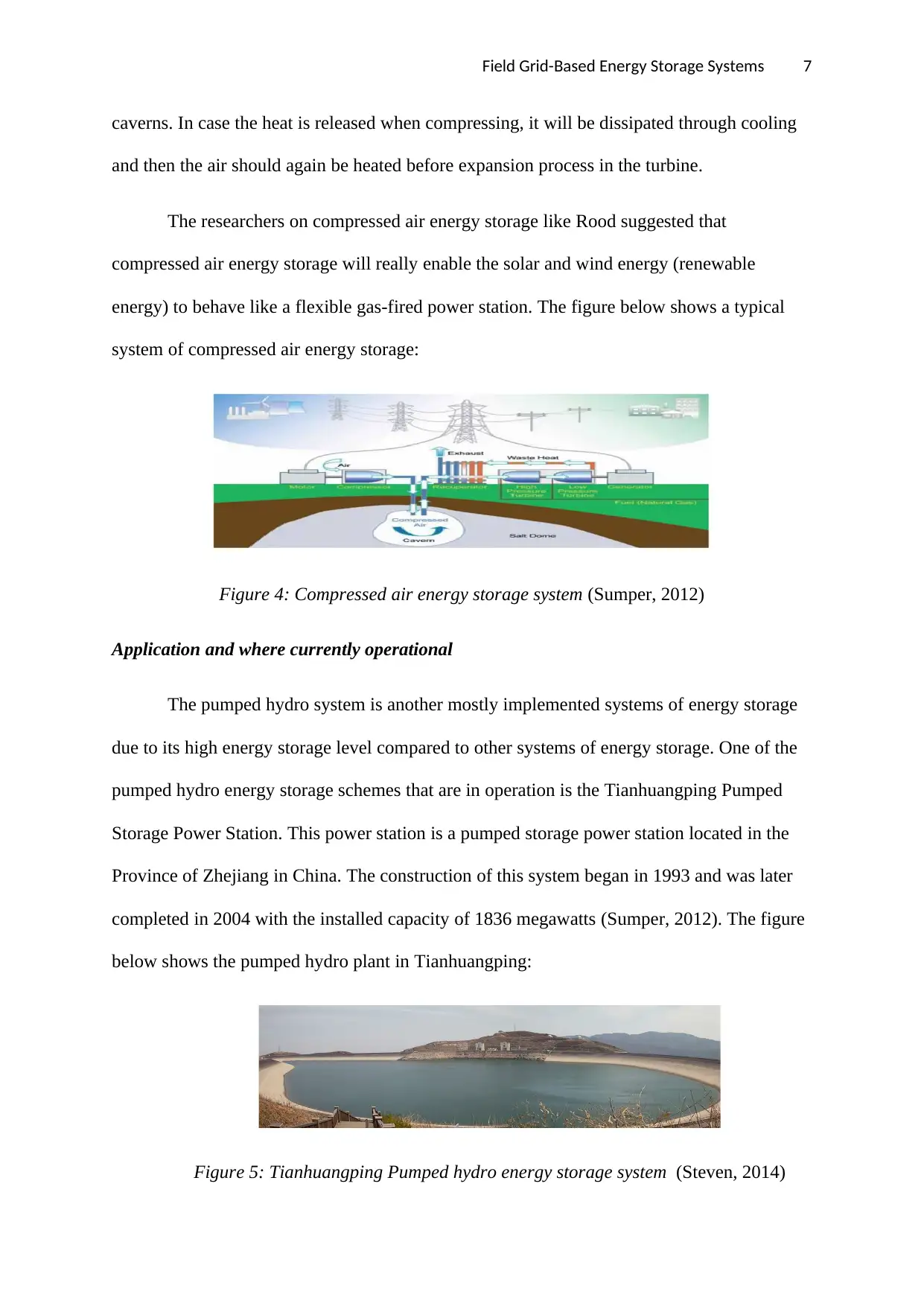
Field Grid-Based Energy Storage Systems 7
caverns. In case the heat is released when compressing, it will be dissipated through cooling
and then the air should again be heated before expansion process in the turbine.
The researchers on compressed air energy storage like Rood suggested that
compressed air energy storage will really enable the solar and wind energy (renewable
energy) to behave like a flexible gas-fired power station. The figure below shows a typical
system of compressed air energy storage:
Figure 4: Compressed air energy storage system (Sumper, 2012)
Application and where currently operational
The pumped hydro system is another mostly implemented systems of energy storage
due to its high energy storage level compared to other systems of energy storage. One of the
pumped hydro energy storage schemes that are in operation is the Tianhuangping Pumped
Storage Power Station. This power station is a pumped storage power station located in the
Province of Zhejiang in China. The construction of this system began in 1993 and was later
completed in 2004 with the installed capacity of 1836 megawatts (Sumper, 2012). The figure
below shows the pumped hydro plant in Tianhuangping:
Figure 5: Tianhuangping Pumped hydro energy storage system (Steven, 2014)
caverns. In case the heat is released when compressing, it will be dissipated through cooling
and then the air should again be heated before expansion process in the turbine.
The researchers on compressed air energy storage like Rood suggested that
compressed air energy storage will really enable the solar and wind energy (renewable
energy) to behave like a flexible gas-fired power station. The figure below shows a typical
system of compressed air energy storage:
Figure 4: Compressed air energy storage system (Sumper, 2012)
Application and where currently operational
The pumped hydro system is another mostly implemented systems of energy storage
due to its high energy storage level compared to other systems of energy storage. One of the
pumped hydro energy storage schemes that are in operation is the Tianhuangping Pumped
Storage Power Station. This power station is a pumped storage power station located in the
Province of Zhejiang in China. The construction of this system began in 1993 and was later
completed in 2004 with the installed capacity of 1836 megawatts (Sumper, 2012). The figure
below shows the pumped hydro plant in Tianhuangping:
Figure 5: Tianhuangping Pumped hydro energy storage system (Steven, 2014)
Paraphrase This Document
Need a fresh take? Get an instant paraphrase of this document with our AI Paraphraser
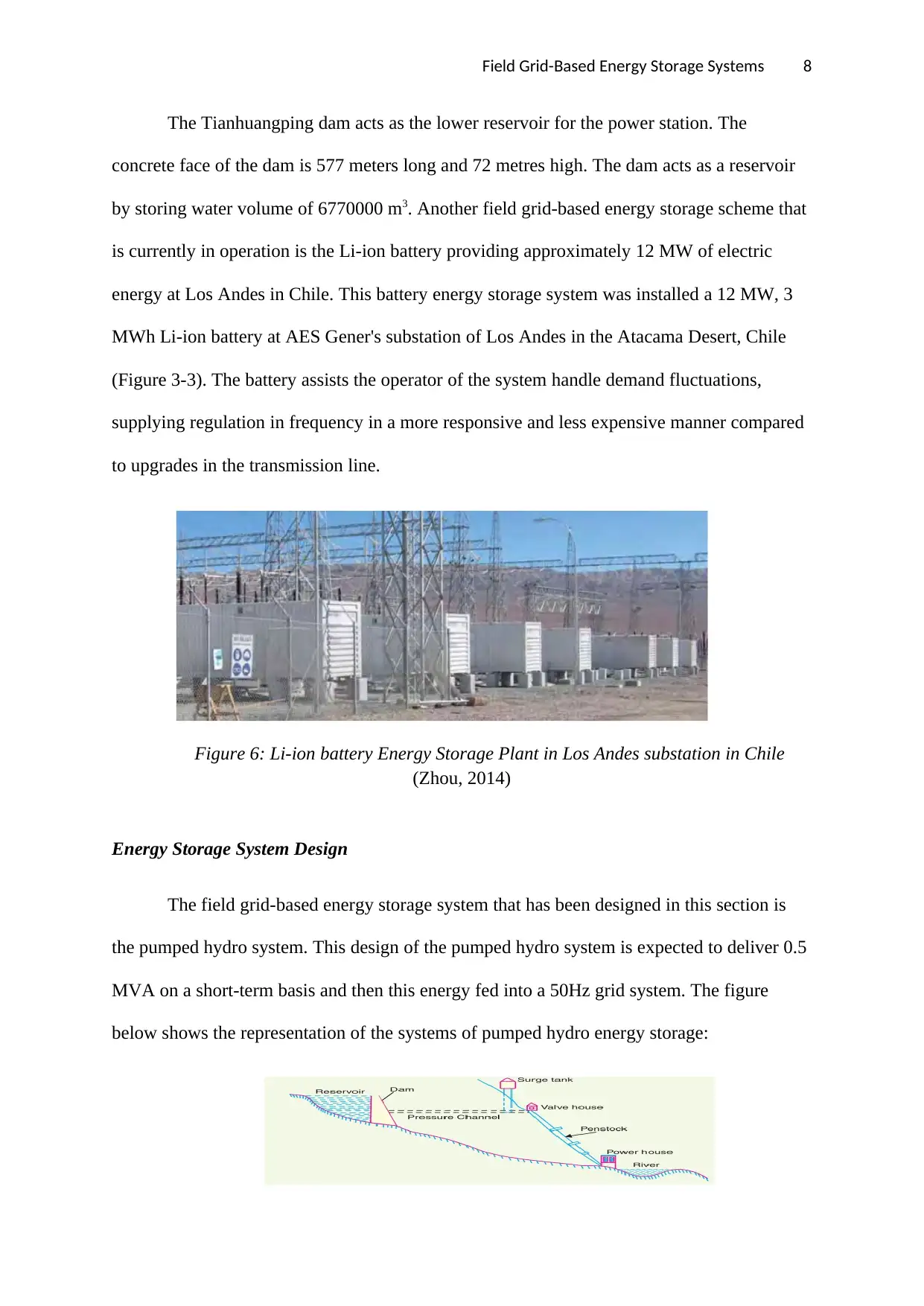
Field Grid-Based Energy Storage Systems 8
The Tianhuangping dam acts as the lower reservoir for the power station. The
concrete face of the dam is 577 meters long and 72 metres high. The dam acts as a reservoir
by storing water volume of 6770000 m3. Another field grid-based energy storage scheme that
is currently in operation is the Li-ion battery providing approximately 12 MW of electric
energy at Los Andes in Chile. This battery energy storage system was installed a 12 MW, 3
MWh Li-ion battery at AES Gener's substation of Los Andes in the Atacama Desert, Chile
(Figure 3-3). The battery assists the operator of the system handle demand fluctuations,
supplying regulation in frequency in a more responsive and less expensive manner compared
to upgrades in the transmission line.
Figure 6: Li-ion battery Energy Storage Plant in Los Andes substation in Chile
(Zhou, 2014)
Energy Storage System Design
The field grid-based energy storage system that has been designed in this section is
the pumped hydro system. This design of the pumped hydro system is expected to deliver 0.5
MVA on a short-term basis and then this energy fed into a 50Hz grid system. The figure
below shows the representation of the systems of pumped hydro energy storage:
The Tianhuangping dam acts as the lower reservoir for the power station. The
concrete face of the dam is 577 meters long and 72 metres high. The dam acts as a reservoir
by storing water volume of 6770000 m3. Another field grid-based energy storage scheme that
is currently in operation is the Li-ion battery providing approximately 12 MW of electric
energy at Los Andes in Chile. This battery energy storage system was installed a 12 MW, 3
MWh Li-ion battery at AES Gener's substation of Los Andes in the Atacama Desert, Chile
(Figure 3-3). The battery assists the operator of the system handle demand fluctuations,
supplying regulation in frequency in a more responsive and less expensive manner compared
to upgrades in the transmission line.
Figure 6: Li-ion battery Energy Storage Plant in Los Andes substation in Chile
(Zhou, 2014)
Energy Storage System Design
The field grid-based energy storage system that has been designed in this section is
the pumped hydro system. This design of the pumped hydro system is expected to deliver 0.5
MVA on a short-term basis and then this energy fed into a 50Hz grid system. The figure
below shows the representation of the systems of pumped hydro energy storage:
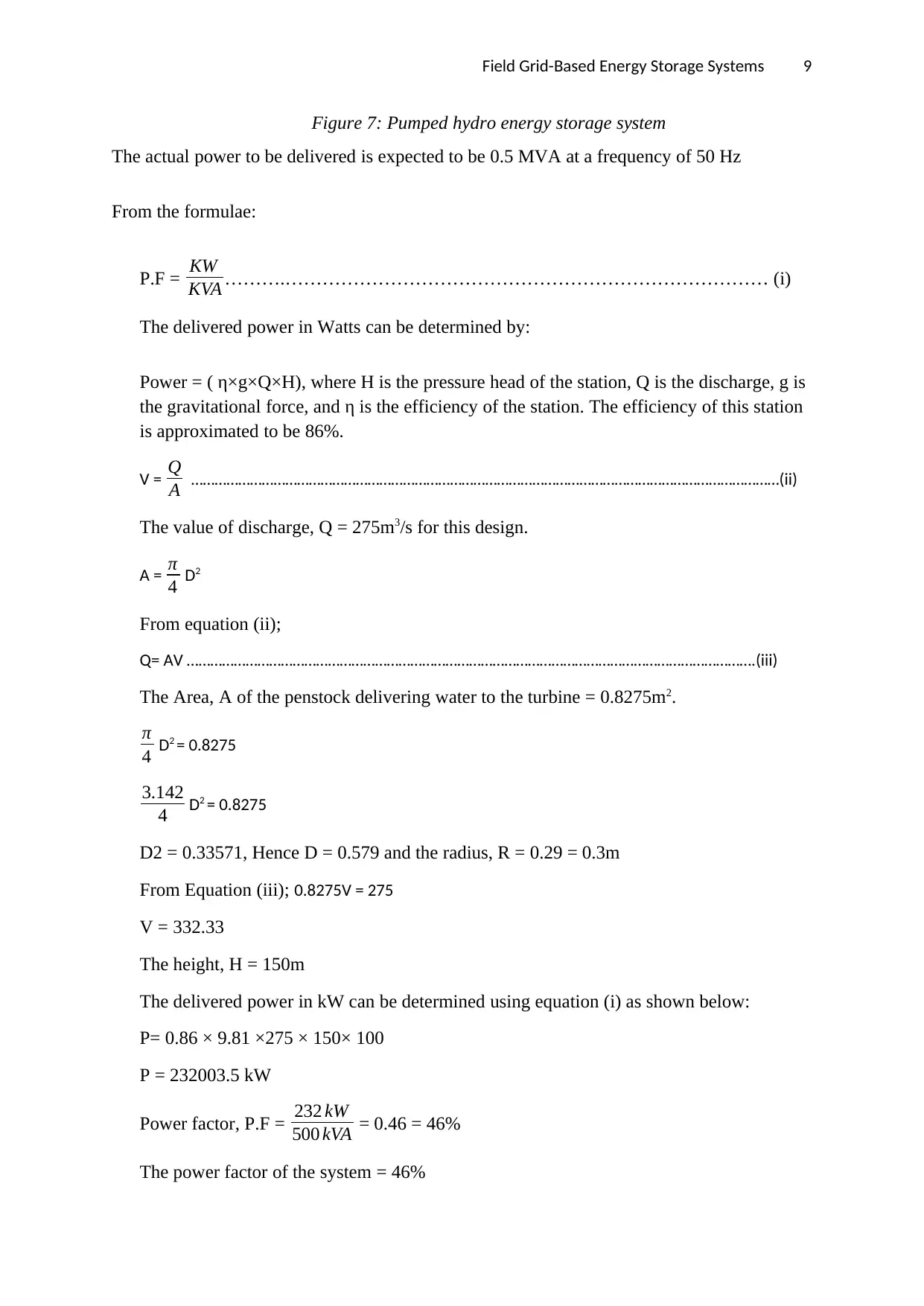
Field Grid-Based Energy Storage Systems 9
Figure 7: Pumped hydro energy storage system
The actual power to be delivered is expected to be 0.5 MVA at a frequency of 50 Hz
From the formulae:
P.F = KW
KVA ……….…………………………………………………………………… (i)
The delivered power in Watts can be determined by:
Power = ( η×g×Q×H), where H is the pressure head of the station, Q is the discharge, g is
the gravitational force, and η is the efficiency of the station. The efficiency of this station
is approximated to be 86%.
V = Q
A ……………………………………………………………………………………………………………………………………(ii)
The value of discharge, Q = 275m3/s for this design.
A = π
4 D2
From equation (ii);
Q= AV ……………………………………………………………………………………………………………………………….(iii)
The Area, A of the penstock delivering water to the turbine = 0.8275m2.
π
4 D2 = 0.8275
3.142
4 D2 = 0.8275
D2 = 0.33571, Hence D = 0.579 and the radius, R = 0.29 = 0.3m
From Equation (iii); 0.8275V = 275
V = 332.33
The height, H = 150m
The delivered power in kW can be determined using equation (i) as shown below:
P= 0.86 × 9.81 ×275 × 150× 100
P = 232003.5 kW
Power factor, P.F = 232 kW
500 kVA = 0.46 = 46%
The power factor of the system = 46%
Figure 7: Pumped hydro energy storage system
The actual power to be delivered is expected to be 0.5 MVA at a frequency of 50 Hz
From the formulae:
P.F = KW
KVA ……….…………………………………………………………………… (i)
The delivered power in Watts can be determined by:
Power = ( η×g×Q×H), where H is the pressure head of the station, Q is the discharge, g is
the gravitational force, and η is the efficiency of the station. The efficiency of this station
is approximated to be 86%.
V = Q
A ……………………………………………………………………………………………………………………………………(ii)
The value of discharge, Q = 275m3/s for this design.
A = π
4 D2
From equation (ii);
Q= AV ……………………………………………………………………………………………………………………………….(iii)
The Area, A of the penstock delivering water to the turbine = 0.8275m2.
π
4 D2 = 0.8275
3.142
4 D2 = 0.8275
D2 = 0.33571, Hence D = 0.579 and the radius, R = 0.29 = 0.3m
From Equation (iii); 0.8275V = 275
V = 332.33
The height, H = 150m
The delivered power in kW can be determined using equation (i) as shown below:
P= 0.86 × 9.81 ×275 × 150× 100
P = 232003.5 kW
Power factor, P.F = 232 kW
500 kVA = 0.46 = 46%
The power factor of the system = 46%
⊘ This is a preview!⊘
Do you want full access?
Subscribe today to unlock all pages.

Trusted by 1+ million students worldwide
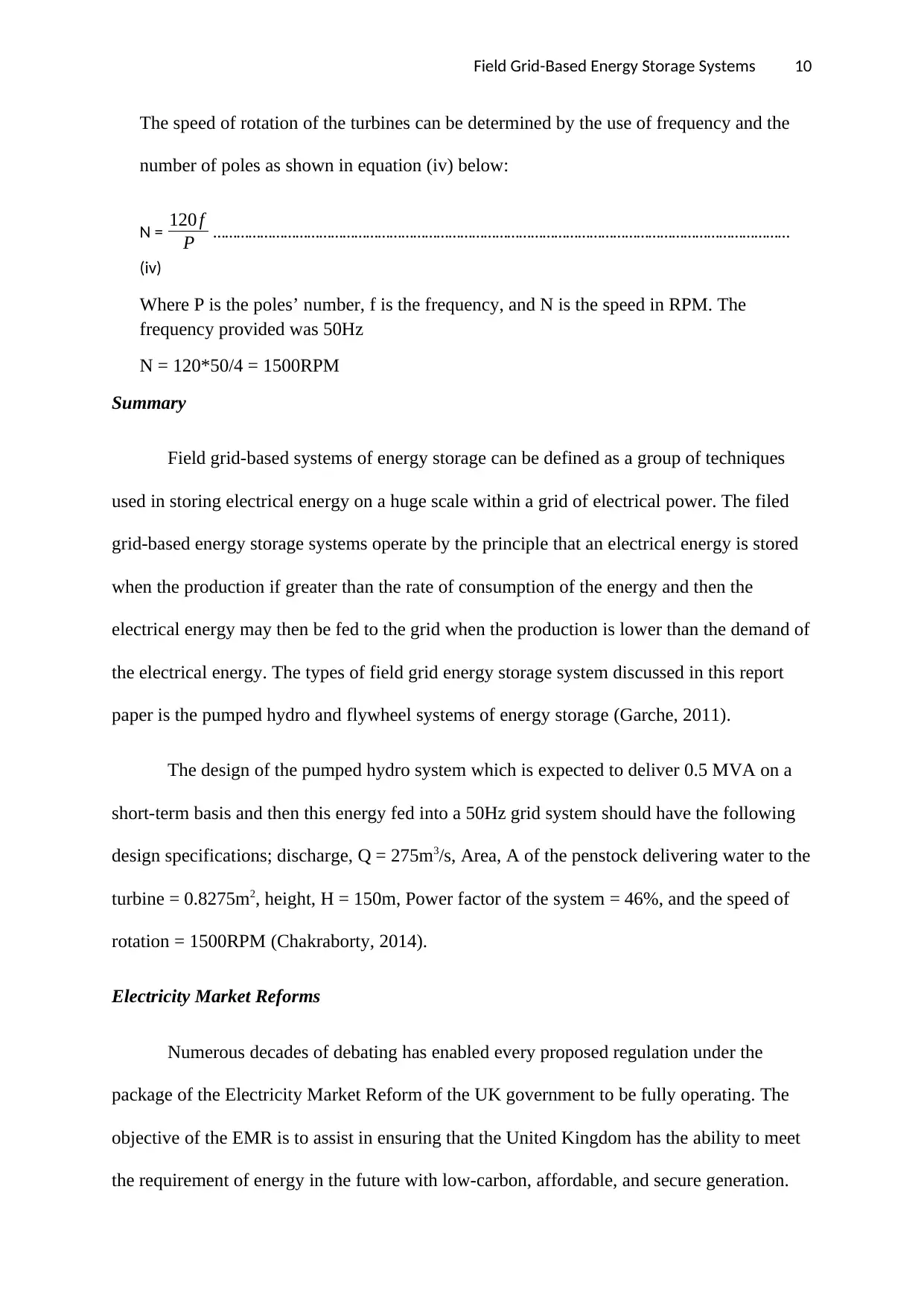
Field Grid-Based Energy Storage Systems 10
The speed of rotation of the turbines can be determined by the use of frequency and the
number of poles as shown in equation (iv) below:
N = 120 f
P …………………………………………………………………………………………………………………………………
(iv)
Where P is the poles’ number, f is the frequency, and N is the speed in RPM. The
frequency provided was 50Hz
N = 120*50/4 = 1500RPM
Summary
Field grid-based systems of energy storage can be defined as a group of techniques
used in storing electrical energy on a huge scale within a grid of electrical power. The filed
grid-based energy storage systems operate by the principle that an electrical energy is stored
when the production if greater than the rate of consumption of the energy and then the
electrical energy may then be fed to the grid when the production is lower than the demand of
the electrical energy. The types of field grid energy storage system discussed in this report
paper is the pumped hydro and flywheel systems of energy storage (Garche, 2011).
The design of the pumped hydro system which is expected to deliver 0.5 MVA on a
short-term basis and then this energy fed into a 50Hz grid system should have the following
design specifications; discharge, Q = 275m3/s, Area, A of the penstock delivering water to the
turbine = 0.8275m2, height, H = 150m, Power factor of the system = 46%, and the speed of
rotation = 1500RPM (Chakraborty, 2014).
Electricity Market Reforms
Numerous decades of debating has enabled every proposed regulation under the
package of the Electricity Market Reform of the UK government to be fully operating. The
objective of the EMR is to assist in ensuring that the United Kingdom has the ability to meet
the requirement of energy in the future with low-carbon, affordable, and secure generation.
The speed of rotation of the turbines can be determined by the use of frequency and the
number of poles as shown in equation (iv) below:
N = 120 f
P …………………………………………………………………………………………………………………………………
(iv)
Where P is the poles’ number, f is the frequency, and N is the speed in RPM. The
frequency provided was 50Hz
N = 120*50/4 = 1500RPM
Summary
Field grid-based systems of energy storage can be defined as a group of techniques
used in storing electrical energy on a huge scale within a grid of electrical power. The filed
grid-based energy storage systems operate by the principle that an electrical energy is stored
when the production if greater than the rate of consumption of the energy and then the
electrical energy may then be fed to the grid when the production is lower than the demand of
the electrical energy. The types of field grid energy storage system discussed in this report
paper is the pumped hydro and flywheel systems of energy storage (Garche, 2011).
The design of the pumped hydro system which is expected to deliver 0.5 MVA on a
short-term basis and then this energy fed into a 50Hz grid system should have the following
design specifications; discharge, Q = 275m3/s, Area, A of the penstock delivering water to the
turbine = 0.8275m2, height, H = 150m, Power factor of the system = 46%, and the speed of
rotation = 1500RPM (Chakraborty, 2014).
Electricity Market Reforms
Numerous decades of debating has enabled every proposed regulation under the
package of the Electricity Market Reform of the UK government to be fully operating. The
objective of the EMR is to assist in ensuring that the United Kingdom has the ability to meet
the requirement of energy in the future with low-carbon, affordable, and secure generation.
Paraphrase This Document
Need a fresh take? Get an instant paraphrase of this document with our AI Paraphraser
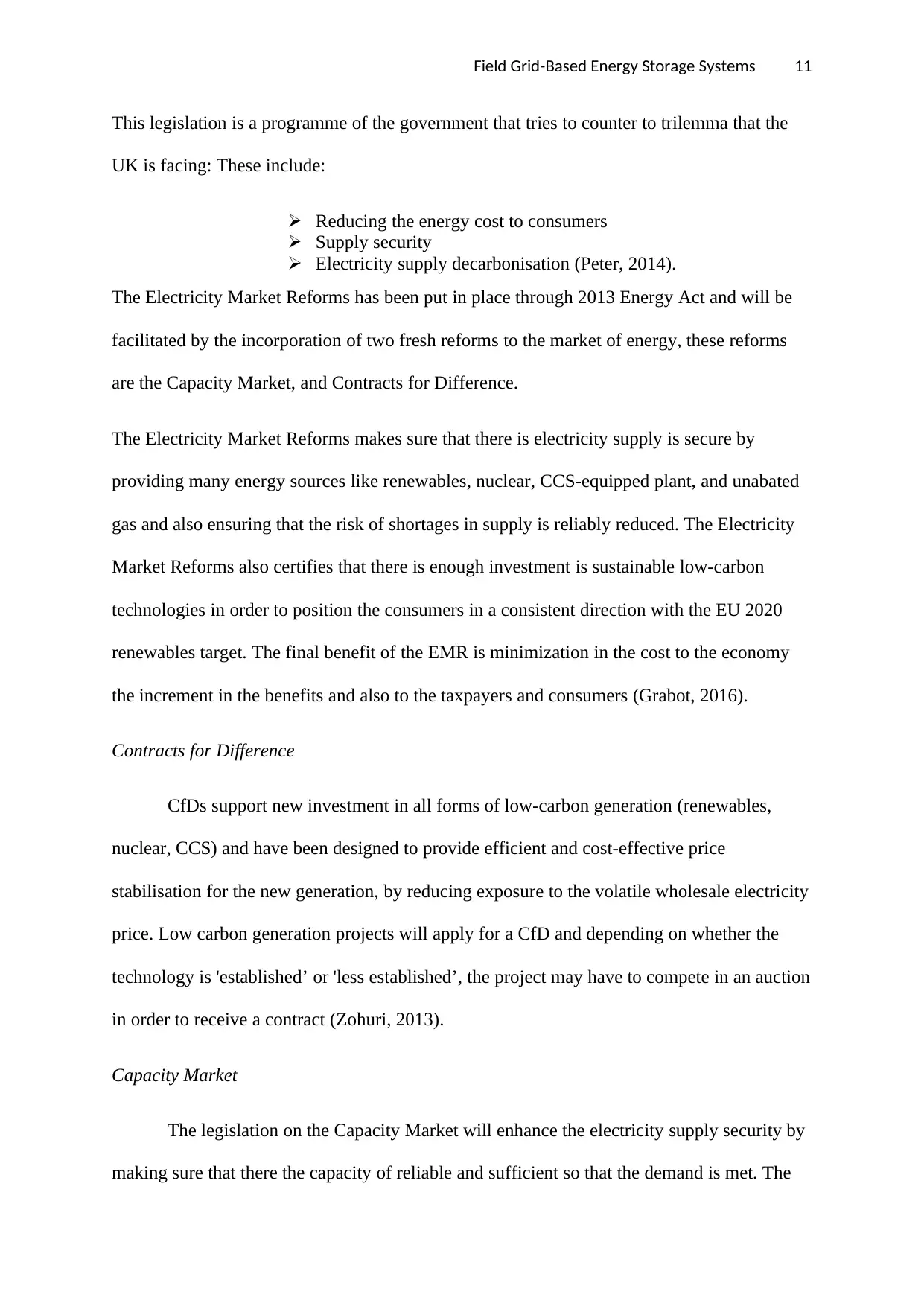
Field Grid-Based Energy Storage Systems 11
This legislation is a programme of the government that tries to counter to trilemma that the
UK is facing: These include:
Reducing the energy cost to consumers
Supply security
Electricity supply decarbonisation (Peter, 2014).
The Electricity Market Reforms has been put in place through 2013 Energy Act and will be
facilitated by the incorporation of two fresh reforms to the market of energy, these reforms
are the Capacity Market, and Contracts for Difference.
The Electricity Market Reforms makes sure that there is electricity supply is secure by
providing many energy sources like renewables, nuclear, CCS-equipped plant, and unabated
gas and also ensuring that the risk of shortages in supply is reliably reduced. The Electricity
Market Reforms also certifies that there is enough investment is sustainable low-carbon
technologies in order to position the consumers in a consistent direction with the EU 2020
renewables target. The final benefit of the EMR is minimization in the cost to the economy
the increment in the benefits and also to the taxpayers and consumers (Grabot, 2016).
Contracts for Difference
CfDs support new investment in all forms of low-carbon generation (renewables,
nuclear, CCS) and have been designed to provide efficient and cost-effective price
stabilisation for the new generation, by reducing exposure to the volatile wholesale electricity
price. Low carbon generation projects will apply for a CfD and depending on whether the
technology is 'established’ or 'less established’, the project may have to compete in an auction
in order to receive a contract (Zohuri, 2013).
Capacity Market
The legislation on the Capacity Market will enhance the electricity supply security by
making sure that there the capacity of reliable and sufficient so that the demand is met. The
This legislation is a programme of the government that tries to counter to trilemma that the
UK is facing: These include:
Reducing the energy cost to consumers
Supply security
Electricity supply decarbonisation (Peter, 2014).
The Electricity Market Reforms has been put in place through 2013 Energy Act and will be
facilitated by the incorporation of two fresh reforms to the market of energy, these reforms
are the Capacity Market, and Contracts for Difference.
The Electricity Market Reforms makes sure that there is electricity supply is secure by
providing many energy sources like renewables, nuclear, CCS-equipped plant, and unabated
gas and also ensuring that the risk of shortages in supply is reliably reduced. The Electricity
Market Reforms also certifies that there is enough investment is sustainable low-carbon
technologies in order to position the consumers in a consistent direction with the EU 2020
renewables target. The final benefit of the EMR is minimization in the cost to the economy
the increment in the benefits and also to the taxpayers and consumers (Grabot, 2016).
Contracts for Difference
CfDs support new investment in all forms of low-carbon generation (renewables,
nuclear, CCS) and have been designed to provide efficient and cost-effective price
stabilisation for the new generation, by reducing exposure to the volatile wholesale electricity
price. Low carbon generation projects will apply for a CfD and depending on whether the
technology is 'established’ or 'less established’, the project may have to compete in an auction
in order to receive a contract (Zohuri, 2013).
Capacity Market
The legislation on the Capacity Market will enhance the electricity supply security by
making sure that there the capacity of reliable and sufficient so that the demand is met. The
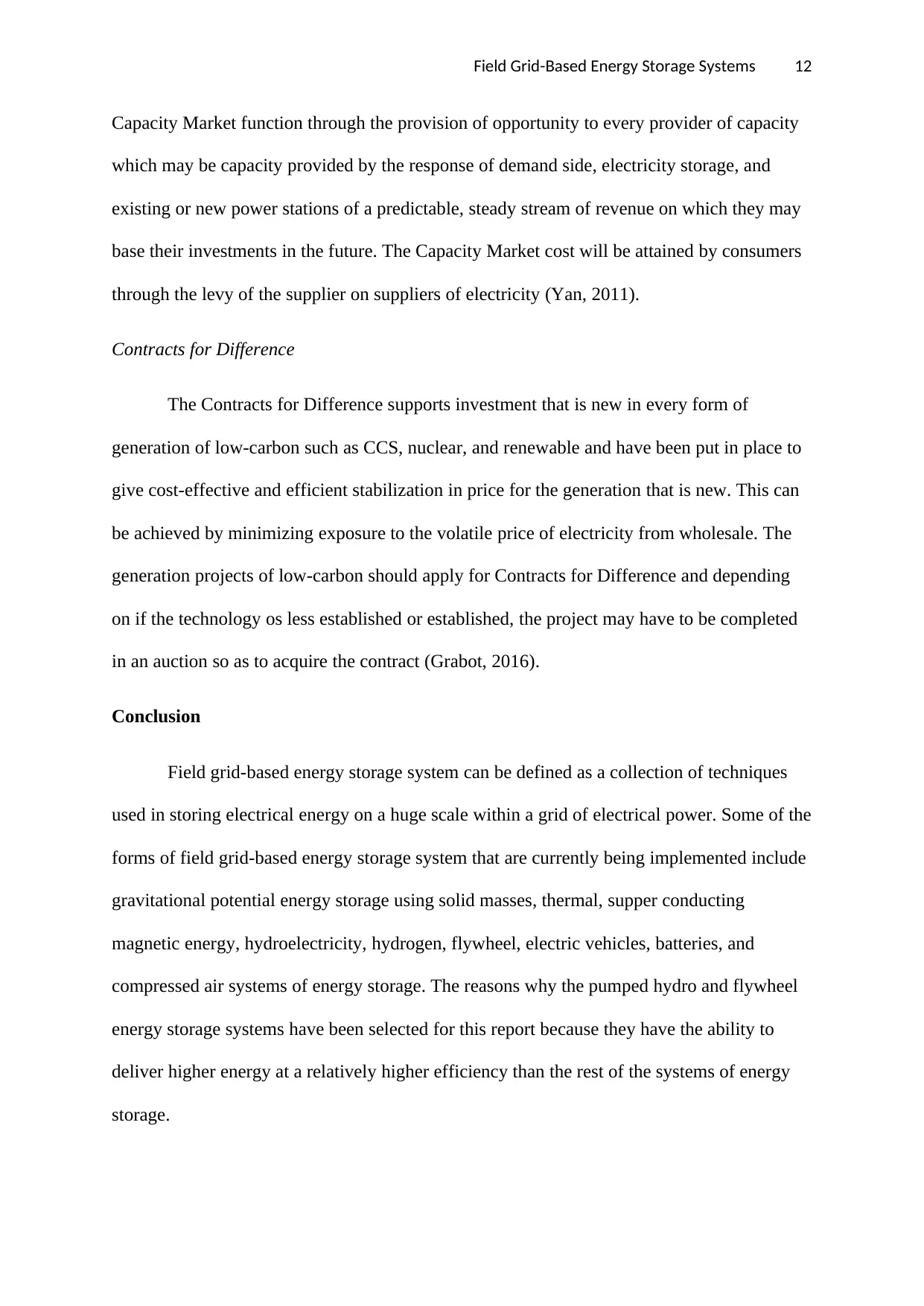
Field Grid-Based Energy Storage Systems 12
Capacity Market function through the provision of opportunity to every provider of capacity
which may be capacity provided by the response of demand side, electricity storage, and
existing or new power stations of a predictable, steady stream of revenue on which they may
base their investments in the future. The Capacity Market cost will be attained by consumers
through the levy of the supplier on suppliers of electricity (Yan, 2011).
Contracts for Difference
The Contracts for Difference supports investment that is new in every form of
generation of low-carbon such as CCS, nuclear, and renewable and have been put in place to
give cost-effective and efficient stabilization in price for the generation that is new. This can
be achieved by minimizing exposure to the volatile price of electricity from wholesale. The
generation projects of low-carbon should apply for Contracts for Difference and depending
on if the technology os less established or established, the project may have to be completed
in an auction so as to acquire the contract (Grabot, 2016).
Conclusion
Field grid-based energy storage system can be defined as a collection of techniques
used in storing electrical energy on a huge scale within a grid of electrical power. Some of the
forms of field grid-based energy storage system that are currently being implemented include
gravitational potential energy storage using solid masses, thermal, supper conducting
magnetic energy, hydroelectricity, hydrogen, flywheel, electric vehicles, batteries, and
compressed air systems of energy storage. The reasons why the pumped hydro and flywheel
energy storage systems have been selected for this report because they have the ability to
deliver higher energy at a relatively higher efficiency than the rest of the systems of energy
storage.
Capacity Market function through the provision of opportunity to every provider of capacity
which may be capacity provided by the response of demand side, electricity storage, and
existing or new power stations of a predictable, steady stream of revenue on which they may
base their investments in the future. The Capacity Market cost will be attained by consumers
through the levy of the supplier on suppliers of electricity (Yan, 2011).
Contracts for Difference
The Contracts for Difference supports investment that is new in every form of
generation of low-carbon such as CCS, nuclear, and renewable and have been put in place to
give cost-effective and efficient stabilization in price for the generation that is new. This can
be achieved by minimizing exposure to the volatile price of electricity from wholesale. The
generation projects of low-carbon should apply for Contracts for Difference and depending
on if the technology os less established or established, the project may have to be completed
in an auction so as to acquire the contract (Grabot, 2016).
Conclusion
Field grid-based energy storage system can be defined as a collection of techniques
used in storing electrical energy on a huge scale within a grid of electrical power. Some of the
forms of field grid-based energy storage system that are currently being implemented include
gravitational potential energy storage using solid masses, thermal, supper conducting
magnetic energy, hydroelectricity, hydrogen, flywheel, electric vehicles, batteries, and
compressed air systems of energy storage. The reasons why the pumped hydro and flywheel
energy storage systems have been selected for this report because they have the ability to
deliver higher energy at a relatively higher efficiency than the rest of the systems of energy
storage.
⊘ This is a preview!⊘
Do you want full access?
Subscribe today to unlock all pages.

Trusted by 1+ million students worldwide
1 out of 14
Related Documents
Your All-in-One AI-Powered Toolkit for Academic Success.
+13062052269
info@desklib.com
Available 24*7 on WhatsApp / Email
![[object Object]](/_next/static/media/star-bottom.7253800d.svg)
Unlock your academic potential
Copyright © 2020–2025 A2Z Services. All Rights Reserved. Developed and managed by ZUCOL.





